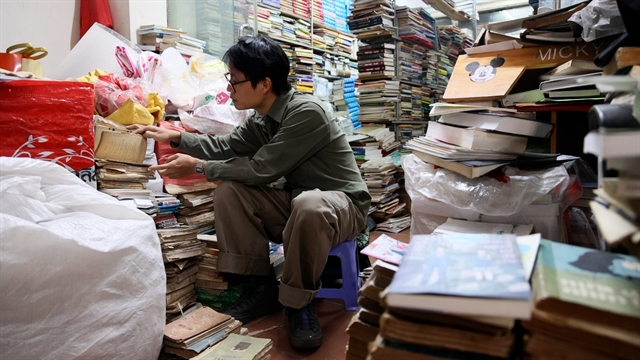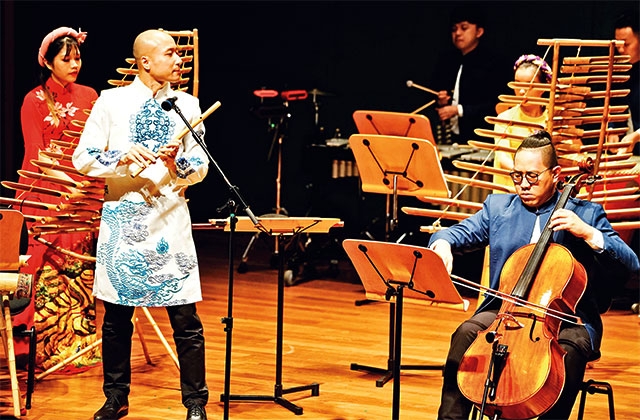 Life & Style
Life & Style


|
| Conductor Đồng Quang Vinh. |
HÀ NỘI The fourth edition of the Tre Mùa Thu (Bamboo in Autumn) concert will be held at the French Cultural Centre (L’Espace) in Hà Nội on Friday and Saturday.
The unique bamboo-made instrument only concert will be conducted by the talented Đồng Quang Vinh.
Việt Nam News reporter Nguyễn Thúy Bình spoke to Vinh about the concert and his bamboo ensemble.
Why will you be playing both world and Vietnamese pieces?
To combine world and Vietnamese music is a tradition of my family because my father is a cello artist and my mother plays traditional instruments.
I like to bring music closer to the audience. I'm lucky to be born into a music family. When my parents were dating, my father made a t'rưng to present to my mother.
T'rưng is a traditional bamboo xylophone used by the Gia Rai people and ethnic Ba Na people in Central Highlands provinces.
My father became skilled at making bamboo instruments.
I have performed abroad with my family since I was 12 years old. I saw foreign audiences liked the combination of western and eastern music. It helps people get closer.
Many of them asked me about Vietnamese đàn bầu (monochord) or t'rưng instrument. But the mass media has not popularised traditional instruments much.
I think the best way to introduce traditional instruments is to play world pieces such as You Raise Me Up or the traditional American song Oh! Susanna.
That is why the blend of east and west is needed in Tre Mùa Thu concerts. It has won the audience's heart and helps to connect people.
Plus, it shows the characteristic of the band and that we know about foreign audience's music and culture.
I like to make good use of this. And I'm happy to see surprise of the audience when they listen to their music played with Vietnamese traditional instruments.
Which Vietnamese pieces will be played at the concert?
I chose two pieces, Về Với Anh (Comeback to Me) and Buôn Làng Vào Hội (Festival in Village) for k'ní and tre lắc (bamboo piano) instruments.
This is the first time the ensemble will use the k'ní. It is is a stringed musical instrument, made from bow branches and is a popular instrument closely associated with the spiritual life of the Ba Na, Xê Đăng, Gia Rai and Ê Đê groups in Central Highlands provinces.
K'ní is a bow string instrument which I think is only in Việt Nam. Like an orchestra, the bamboo ensemble has percussion, wind and string instruments.
But Vietnamese string instruments include plug strings and bow strings. The plug string instruments like đàn tranh (16-chord zither) and đàn nguyệt (two-chord zither) were introduced at the last concerts.
The second piece will be for the tre lắc instrument played by soloist Đồng Văn Minh. He created this instrument in 1988.
What about The Carnival of the Animals, is it the first time the ensemble will play it?
Tre Mùa Thu concert always features a new repertoire. It can be said no traditional ensemble has played this piece.
It was composed by French Camille Sant Saens who was one of the earliest famous people to visit HCM City and Côn Đảo Prison.
The piece is popular, humourous musical piece and lasts around 25 minutes. It is understandable for the audience I want to draw to the concert.
This is also the first time the bamboo ensemble will perform with a piano, cello and oboe.
What does Vietnamese folk music have in common with classical music?
The biggest common point is the emotion of the listener. The second is systematic. Eastern and western music both have solo and ensemble performances.
When playing individually each instrument brings something into play. Vietnamese string instruments such as đàn nhị, đàn tranh and đàn tỳ bà (four-chord lute) can be used alongside the western violin, viola and cello.
We have different kinds of bamboo flutes as wind instruments. There are many kinds of percussion instruments.
I understand the more I have learned the more commonalities I see. From this, I realise that I should not define what is western or eastern music. Just that I'm from Việt Nam and I belong to the musical world.

|
| Bamboo Ensemble performed in Singapore in August. Photos coutersy of organisation board |
You studied traditional music at the Việt Nam National Academy of Music. When did you become interested in classical music?
It wasn't my plan. I studied at the academy to play not only bamboo flute but other instruments.
I want to have more compositions for traditional instruments. Classical music has a huge number of compositions.
Vietnamese traditional music is rich. But it hasn't been taught to younger generations systematically, but mainly orally.
When the masters pass away the pieces are not written on paper. I'm trying to preserve and develop traditional pieces.
My teachers saw my efforts and decided to send me to study at the Shanghai Conservatory of Music. VNS